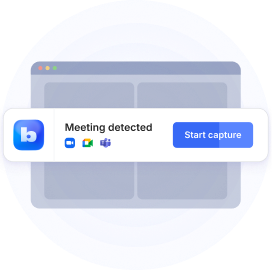
Many meetings conclude with a list of action items, yet those tasks often go uncompleted. This guide provides you with the tools to conduct a meeting evaluation to ensure you strengthen your follow-up strategy for the next meeting.
Learn how to streamline the process, promote accountability amongst participants, and propel projects forward. By implementing these effective strategies, unproductive meetings will be a thing of the past.
6 Post-Meeting Evaluation Tips
Effective meetings are the cornerstone of a productive team. However, simply convening a meeting doesn't guarantee success. To leverage the power of collaboration, a strong post-meeting evaluation process is crucial.
By taking the time to assess meeting performance and insights gained from participants, you can continuously improve future meetings, ensuring they become catalysts for achieving goals and driving better results. Here's how to do exactly that:
1. Schedule time for a meeting review
Allocate dedicated time in your schedule for a comprehensive meeting assessment. Create a slot in your day to reflect on the key takeaways, outcomes, and areas for improvement from the recent meeting. By prioritizing this step, you ensure that the insights gained during the evaluation process are thoroughly analyzed and incorporated into future meetings.
This proactive approach not only enhances the quality of your meetings but also fosters a culture of continuous improvement within your team or organization.
Example:

2. Review your meeting notes
During your scheduled meeting assessment, conduct a thorough examination of the meeting notes. Look beyond basic action items and delve deeper into the details. Analyze the flow of the conversation, pinpointing areas where discussions deviated from the agenda or key points weren't fully addressed.
This analysis will help you identify areas for improvement in future meetings, such as ensuring clear communication or allocating enough time for specific topics.
Example:

3. Manage the execution of action items
Taking control of action items is paramount to transforming meeting discussions into tangible results. Don't let these tasks fall into a black hole of forgotten responsibilities. Utilize a project management tool or a simple shared document to clearly outline each action item.
Assign ownership to specific individuals, including clear deadlines and expected deliverables. Schedule check-ins or progress updates to hold everyone accountable and ensure projects stay on track. By establishing a system for monitoring action items, you'll guarantee that decisions translate into meaningful action.
Example:

4. Encourage meeting survey questions and feedback
Not all meetings are created equal, and gathering participant feedback is essential for continuous improvement. Encourage your group's willingness to provide feedback by offering a quick and easy meeting survey. This can be as simple as a standard survey with a few key evaluation questions or even a letter grade system.
Whether conducted electronically after a video conference or distributed at the end of an in-person meeting, gathering feedback allows you to identify areas for improvement and tailor future meetings to be more effective. By incorporating participant perspectives, you'll be well on your way to hosting consistently better meetings.
Example:

5. Send a follow-up email
Following up with a concise email after your meeting review strengthens communication and keeps everyone aligned. Within 24 hours of your review, send a clear and concise email summarizing key decisions, action items, and deadlines.
Include the assigned owner for each action item and any relevant resources or attachments. This email serves as a central reference point for everyone involved, promoting transparency and ensuring all participants are on the same page moving forward.
Example:

6. Plan the next steps
Don't let the momentum die after a productive meeting review. Use the insights and feedback gathered to inform the planning of future meetings. Consider what topics require further discussion, who needs to be involved, and the best format for the next session.
By proactively planning the next steps, you ensure that your meetings remain focused and productive, and drive progress towards achieving your goals.
Conclusion
By implementing these six meeting evaluation tips, you can transform your meetings from time-consuming talks into action-oriented drivers of success. Taking the time to review key takeaways, hold participants accountable, and incorporate feedback fosters a culture of productivity and goal achievement.
However, managing all these moving parts – notes, action items, deadlines, and feedback – can quickly become overwhelming. That's where Bluedot comes in. Bluedot is a platform designed to streamline your process and maximize the value of every meeting.
With Bluedot, you can harness the power of AI to automatically record your meetings, generate precise transcripts with timestamps, and collaborate on comprehensive notes – all within a centralized and user-friendly platform.
It also empowers you to assign clear action items by means of the notes it auto generates during the meeting, and even draft follow-up emails summarizing key decisions. Plus, you can easily gather participant feedback to ensure continuous improvement. Install free extension.
FAQs
How soon should meeting follow-ups be sent?
Ideally, post-meeting follow-ups should be sent as soon as possible after the meeting while the discussion is still fresh in participants' minds. This ensures that action items are promptly addressed, and there is no delay in implementation.
Why are meeting follow-ups important?
Post-meeting follow-ups are essential for ensuring accountability, clarifying action items, and maintaining momentum toward achieving meeting objectives. They help prevent miscommunication, ensure alignment among team members, and maximize the effectiveness of meetings.







